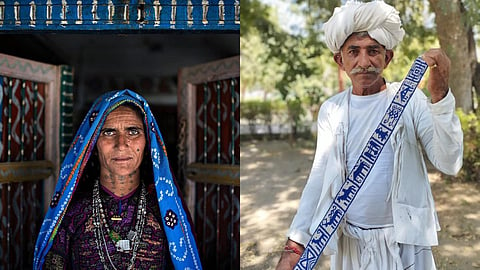
- HOMEGROWN WORLD
- #HGCREATORS
- #HGEXPLORE
- #HGVOICES
- #HGSHOP
- CAREERS
- ABOUT US
- CONTACT US

Ply-split braiding is an ancient craft form that originated in northwestern India. What makes it unique compared to other forms of braiding or weaving is its technique. Here, one twisted cord (splitter) passes through another twisted cord or multiple cords splitting the plies of the latter cords (splittee cords). In common forms of braiding or weaving cloth is formed by threads interlacing in an over-under sequence. The pattern is formed by different cord colors and the order of splitting. Ply-split braiding has a rich 700-year-old history that is quite fascinating.
The history of the practice of ply-split braiding is interwoven with the history of the Rabari tribe. The Rabari, also known as the Rewari or Desai, are an indigenous tribal caste of nomadic shepherds, cattle, and camel herders that reside throughout northwestern India, majorly in the states of Gujarat, Punjab, and Rajasthan. Some section of the Rabari population is also found in the region of the Sindh Desert in Pakistan. The word 'Rabari' translates to 'outsiders', which is an apt description of their major occupation and station within Indian society.
One can spot a Rabari by their three distinctive features —their tattoos, jewelry, and their occupation. The most common ink on their bodies is a tattoo of a scorpion on the finger. Scorpions hold a sacred distinctive place in Rabari culture. They believe that a scorpion is an avatar of Lord Krishna, who protects them during their arduous journeys on foot through forests. Rabari women are adorned with jewelry such as large nose rings supported by a chain attached to the hair while upper arm bangles are worn by married women. An easy way to identify which region a Rabari woman hails from is the jewelry. Typically, women withbracelets on their arms are from Rajasthan and those without bracelets but are covered with tattoos are from Gujarat.
Traditionally, the main source of income for the Rabari community is livestock - selling camel milk, sheep wool, and/or the animals themselves. Even twenty years ago, camels used to be sold at fairs in Bikaner, Rajasthan but now the trade is rapidly declining owing to climate change, reduced demand, and changes in lifestyle. As a result, more and more members of the Rabari community are shifting towards the cities.
A Rabari, with their nomadic lifestyle, has to travel huge distances. To provide support to the riders, a wooden frame called a Kathu, was fitted on the camel’s hump. It was attached to the camel with a ply-split braided belt called a 'Tang'. Tang, a traditional Rabari camel belt, is a 700-year-old craft that has organically developed over the years through the exchange of knowledge within the community. The nomadic tribe spends much of the year in forests. As a result, their environmental surroundings inspire the motifs of Tang, which have also evolved over the years. The most common motifs are camels, panihari (women with water pots on their heads), and scorpions. All Tang motifs are made at a 90-degree angle and look similar on both sides.
The craft of ply-split weaving was also used to create camel regalia and decorate them for festivals. Now, the practice has completely ceased in the Rabari community and only museums can attest to the decoration of camels. Only a few of the elders have kept the practice of ply-split weaving alive. As the practice among the Rabaris declined, it was eventually picked up by other communities. Even then only a handful of artisans from other communities have what it takes to craft a truly impeccable Tang Belt.
Despite its decline, modern-day designers and artists have picked up the craft. The ply-split braiding technique is used by fiber artists to create handmade decorative items such as neckwear, bags, household decorations, garments, and structures such as baskets and sculptures.
Today’s braid makers employ materials such as cotton, linen, hemp, silk, paper, or rayon in their ply-split braiding process. It is a method that requires minimal equipment but a high degree of skill. Even though the practice is no longer prevalent in the community where it was born 700 years ago, it has still found its way to modernity.
If you enjoyed reading this, here's more from Homegrown:
A Look At India’s Tribes And Its Traditions Of Tattoos
